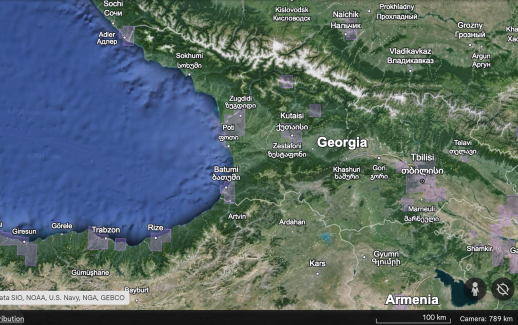What Caspian States Can Do If Russia Tries to Misuse Treaty to Co-Opt Them for Putin’s Wars
The Set-up
In the Spring of 2018, during negotiations leading to the execution of the Convention on the Legal Status of the Caspian Sea on August 12, 2018 by Russia, Kazakhstan, Turkmenistan, Iran, and Azerbaijan, the Russian Ministry of Defense took two actions to coerce the other parties: (1) the April 2018 relocation of the Russian Navy’s Caspian Flotilla Headquarters to Kaspiysk, Dagestan 550 miles South of its previous base in Astrakhan; (2) and its May 2018 addition of “32 amphibious armored personnel vehicles to the Caspian Flotilla—a strategic move that increased the flotilla’s ability to conduct landings anywhere along the Caspian shoreline.” These moves followed a significant buildup of the Russian Navy’s Caspian flotilla from 2010, including an air wing, naval infantry, and new generation missile warships.
Russia’s build-up, pre-treaty installation of coastal landing capability, naval infantry, and anti-submarine potential of the new air wing in the Caspian sent a coercive message to the other Caspian Sea powers negotiating a treaty to settle rights to Caspian Sea resources since 1996. The coerciveness of the message took on more gravity as Russia had seized Crimea and intervened for the Assad regime in the Syrian Civil War within four years of the signed Convention, using Caspian Sea military assets to bomb Syrian cities.
Caspian Sea Flotilla’s Use in War of Aggression on Ukraine
In February 2022, the Russian Defense Ministry announced exercises involving roughly 20 warships from the Caspian Sea flotilla including ‘the missile ship Dagestan, small missile ships Grad Sviyazhsk, Uglich, Velikiy Ustyug, Makhachkala, Astrakhan and Stupinets, small artillery ships, base sweepers, cutters, and support vessels.’
Since then, Russia has used the Caspian Sea flotilla’s missile vessels and warplanes in Caspian airspace to bombard Ukrainian infrastructure, civilian residential structures, and military targets. Russian leadership has also ordered weapons from and through Iran via the Caspian Sea to use against Ukraine, inviting justified interdiction on the Caspian route as self-defense.
Perhaps it was the possibility of retaliation against its standoff offensive assets staged in the Caspian Sea that Moscow had in 2014 exacted a declaration of the Caspian Sea as an exclusionary zone against non-Caspian militaries (Kremlin press release website, not secure), implying that Caspian littoral states would share a duty enforce the declaration.
By militarizing the Caspian Sea itself and allowing other Caspian states to do so, Russia could argue that any outside retaliation against Russian forces operating in the Caspian Sea constitutes non-littoral states’ military presence in the Caspian Sea, triggering an obligation for other Caspian states to join Russia in repelling same.
Putin might then argue that if Caspian states did not join Russia’s side to defend their portions of Caspian Sea and airspace through which pass outside military opponents’ retaliatory strikes against Moscow’s naval vessels, warplanes, and airspace, it would violate the Convention, permitting Russia to abrogate the treaty and leverage its overmatching Caspian military resources to take control of the Sea and its resources for its own ‘national defense’ interests.
What Can Caspian Sea Powers Do To Escape Russia’s Attempted Military Co-option?
If Moscow tries to use the Caspian Sea Convention as a coercive instrument to co-opt other Caspian Sea nations as shields or proxy defense forces to its wars of aggression, other Caspian Sea powers can counter-argue that Russia had already violated the good faith provision of the Convention to keep the Caspian Sea a peaceful zone for all Convention members by aggressing against Ukraine using its Caspian Sea flotilla’s missile ships and Caspian airspace for air-launched bombardment, provoking and inviting non-littoral state warfare in the Caspian Sea zone. The other states can argue that they did not agree to support or defend against the consequences of aggression by a fellow member or members.
Concluding Thoughts
In his Hudson Institute analysis of Russia’s use of the Caspian Sea from which to strike Ukraine, supply the Russian Black Sea fleet, and supply its ongoing war against Ukraine, Luke Coffey argued: “In the context of regional security, military planners in the United States and NATO should see the most extreme point of the alliance’s Black Sea frontier as the southern shoreline of the Caspian Sea.”
While Coffey’s point is taken regarding NATO strategic contingency planning should the Russian and or Iranian sponsorship of Russian state terror against Ukraine expand against NATO member nations, it could more immediately and justly apply to the Ukraine Defense Contact Support Group’s removal of range restrictions on Ukraine’s equally proportionate use of longer range weapons to strike Russia’s longer range weapon systems and supplies attacking or supplying attacks on Ukraine from the Caspian Sea surface and airspace.
The Ukraine Defense Contact Support Group, by ceasing to restrict Ukraine’s proportionate right to self-defense under international law can help shorten the war of aggression and save lives of the innocent parties to the war as well as end incentives for Moscow to continue compelling its citizens and territorial conscripts to fight in its illegal war of aggression.
